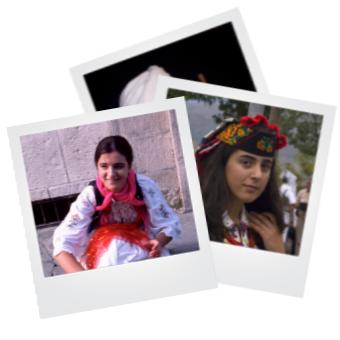Traditional Costumes in Albania
Like in many European countries, the traditional costumes have vanished almost completely from daily life. However, if you are lucky you may find some people in full dress, most of the time elder women from the villages, when they are going to market or to a special occasion.
The folk costumes of Albania show a great diversity in styles and patterns, not to mention the colours used, ranging from a simple black and white to purple, green, orange and deep blue. All of this in a country of just about 3 million people, and just the size of 29.000 square kilometres. It seems every village has its own costume and within it may be divided even by religion, class, age or social position. The basic garments can be identified as belonging to just a few groups, but the way these have evolved in different places, has resulted in a great diversity.
Museums
If you are not so lucky, you still can see the costumes in the Ethnographic museums of Berat, Gjirokastër, Elbasan, Krujë and other places. Most of the time they have parts of the costumes and some museums have complete costumes on display.
Festivals
When you have the privilege of attending a folklore festival, like the Gjirokastër national folklore festival, held once in 5 years in Gjirokastër, you will see a lot of costumes from different regions together. Some of them are authentic; others are copies, prepared for the stage performance.
Shops
In Tirana you may find several souvenir shops, who are selling costumes. Some are authentic or authentic parts; others are copies or made for children. It is also possible to hire costumes for a certain occasion like a wedding or birthday party. In the National History Museum in Tirana you can also buy women’s waistcoats, mostly from the Krujë area. In Krujë itself you may find some shops in the old bazaar selling also parts of costumes.
Postcards
Of course you can find nice postcards with costumes, most of them taken at the Gjirokastër festival.
Books
Best however is a series of books published by the Academy of Sciences, ethnology department. The whole series would be five or six volumes, of which now three has been published, covering the southern parts, the central part and the western part of the North. The volumes contain many fine pictures of people in full dress together with a general text about the area per chapter, written by several specialists in the field. Text as well as captions are in English and in Shqip. They are available in larger bookshops and cost about 4500 Lek each, which is about 40 Euro at the moment. See the books on Costumes in the Books listing.
A more in-depth study can be found in the book by Prof Andromaqi Gjergji: Albanian costumes through the centuries, also published by the Academy of Sciences and completely in English. The book starts with the historical aspects, followed by a classification of the types and then referring to details. It certainly is a scientific study, not a picture book.
Other specific articles on costumes can be found in the magazine Kultura Popullore, also published by the Academy of Sciences.
History
Thanks to early descriptions, drawings and paintings, mostly by Western European visitors, scientists, journalists or just tourists, there is a more or less clear picture about the evolution of the Albanian folk costumes and the effects of fashion.
Dr. Franz Baron Nopsca made a full survey of the costumes of the Mirdita region, complete with patterns of the different parts in the book “Albanien, Bauten, Trachten und Geräte Nordalbaniens”, published by Walter de Gruyter & Co, Berlin and Leipzig in 1925.
Three generations of the Marubi photographers from Shkodra have saved us many images of folk costumes from the late 1880’s till the early 1930’s, mostly from around Shkodra.
Other people like Delacroix, Pouqueville, Lord Byron, and Edith Durham have contributed to the knowledge of the folk costumes in times past.
After WWII the interest in folklore in general and in costumes in particular under the socialist regime took an important part in the Science Academy and many costumes and parts were collected, archived and well described.

